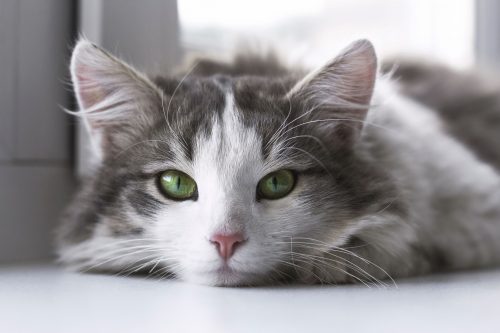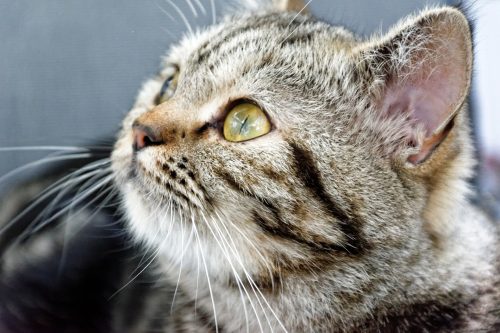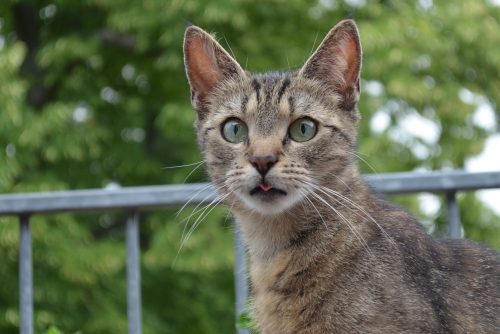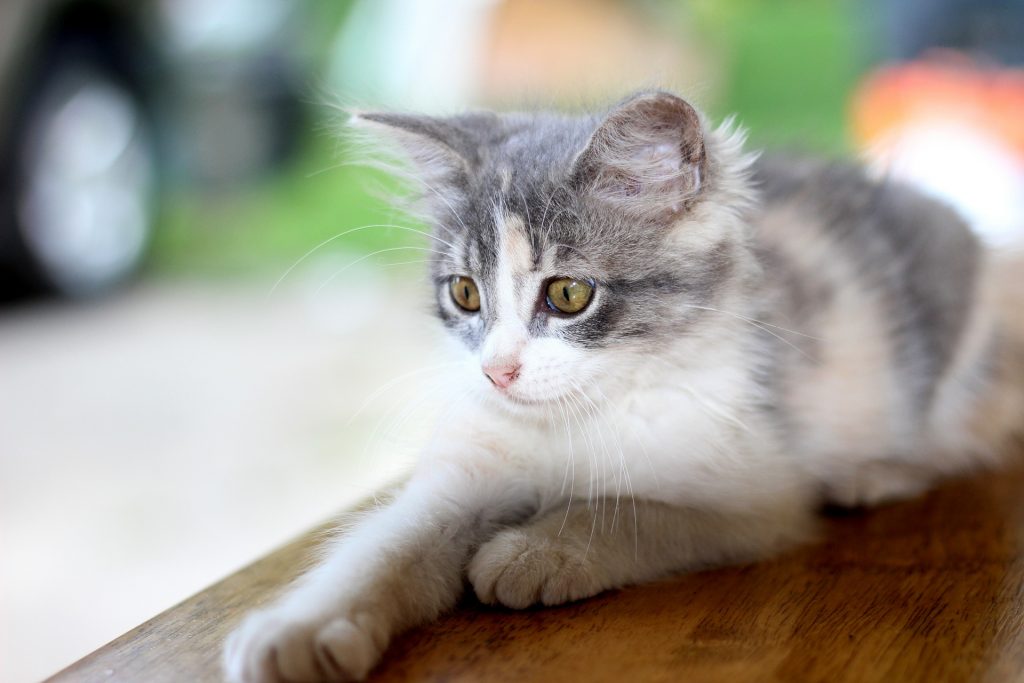A cat that poops regularly is a healthy cat. And most likely, a happy cat! Just like people, cats need regular bowel movements to expel waste and toxins, and keep their little bodies in tip-top shape.
As a rule of thumb, your cat should be pooping at least once a day, although a cat’s bowel movements can vary at times. If you find that your cat does not seem to be pooping every day, or you find that your cat is exhibiting behaviors of stress or anxiety while attempting to pass a bowel movement, then more than likely, constipation is the culprit.
A healthy bowel movement for a cat should look relatively solid and well-formed, and be a deep brown in color. It should also be somewhat moist. If the kitty litter sticks to it, that’s a good sign.
Your cat should not display excessive straining, mewling, or other behaviors that signal discomfort when having a healthy bowel movement. However, just because they don’t show any of those signs, doesn’t mean the plumbing can’t still be backed up.
In fact, a constipated cat may not always show signs he is constipated, which is why it’s important to monitor your kitty’s bathroom habits, and make sure he is defecating regularly.
Remember, a healthy cat should have at least one normal bowel movement every day. If they aren’t having at least one, it’s important to figure out why, so you can begin to correct the problem.
What is Constipation in Cats?

Constipation occurs when your cat experiences stools that are large and/or hard, and it makes it difficult to move them through the colon and expel them. The condition appears to affect middle-aged male cats more than others.
Bowel movements in a cat can be infrequent and downright hard, or sometimes just… incomplete. If left untreated, constipation can progress into a condition called obstipation.
Obstipation is basically an extreme case of constipation that does not respond to medical treatments, and makes defecation for your cat all but impossible.
Though this is quite a common problem, it can be avoided entirely, with proper care and monitoring. That’s why it’s so important to keep an eye on your cat’s bowel movements and make sure he is going every day.
Causes of Cat Constipation
More often than not, constipation signals that your cat is dehydrated. Sometimes cats can become constipated due to stress and anxiety, or because defecation is painful for some reason. Other times, your cat can become constipated due to mechanical or functional obstructions, or even metabolic disease.
Other Causes of Constipation in Cats
- Feline obesity
- Trauma
- Lack of regular exercise
- Excessive fiber intake
- Change of environment, such as a hospitalization or a move
- A dirty litter box
- Swallowed hair or bones
- Foreign materials they’ve ingested
- Aggression between your cat and another cat, which makes him afraid to use their own litter box
- Low blood calcium
- Low blood potassium
- Low thyroid hormone levels
- Intestinal blockages
- Muscle weakness
- Fractured bones
- Arthritis
- Neurological problems
- Impacted anal glands
- Tumors and hernias
- Rectal Obstructions
- An underlying symptom of diabetes
- Megacolon
Despite all the many “possible” causes constipation, dehydration and an inadequate intake of fluids are typically culprit number one, so it’s important to pay attention to how much your cat is getting to drink on a daily basis.
While dehydration is a common cause of constipation, it is second only to a cat suffering from megacolon. This is a condition where your cat’s colon experiences a gradual loss of muscle tone, which makes it harder and harder for your cat to poop.
Megacolon can lead to a serious and painful case of impaction. It can even result in your cat eventually needing to be euthanized, simply to put an end to their suffering.

Signs and Symptoms of Cat Constipation
Just like there are multiple potential causes for constipation in your cat, there are also several potential signs and symptoms to alert you something may be amiss.
If you notice your cat seems to be straining while defecating, with very little feces as a result, that could be a warning sign of constipation.
If your cat defecates infrequently or even not at all (which happens sometimes), that’s a clear warning sign of a constipated cat.
Sometimes a cat may produce a liquid looking stool that contains mucus and possibly blood. This is usually due to straining for a long period of time in an attempt to defecate.
Cats can suffer from depression and lack of appetite as well with constipation, and even experience vomiting and swelling around their anus.
Another warning sign is your cat’s stomach. If it feels very hard to the touch, it could be an indicator that his large intestine is filled with compacted fecal matter.
Other signs of constipation can be weight loss and lethargy, and a noticeable lack in their typical grooming habits.
Diagnosing a Cat with Constipation
Unfortunately, if you suspect that your cat is constipated, you may need to schedule a visit with your veterinarian. Especially if the situation is getting bad, and diet changes and water monitoring doesn’t seem to be improving the situation.
Your veterinarian will want a very thorough background history, and they may request blood chemistry profiles, blood counts, a urinalysis, and an electrolyte panel, just to make sure everything is looking as it should.
They may also require an x-ray, especially if they believe your cat is impacted.
Treating Your Cat for Constipation
There are typically five measures that may be taken in an attempt to relieve your cat’s constipation. The first step of course, is rehydrating your kitty.
Depending on the severity of the dehydration, your vet may require fluid therapy through an IV, but not always. When they don’t use the IV, subcutaneous therapy may be used instead as a way to rehydrate your feline. Just be careful to follow your vet’s instructions exactly, as it is possible to over-hydrate your cat, which can be just as dangerous as dehydration.
The next step that may be taken is removal of the feces. Removing feces from your cat can be done with an enema, or by using manual extraction. Some vets may choose to use pediatric rectal suppositories. Most vets will require your cat to be sedated, whatever the process of removal that is chosen.
Never use over-the-counter enemas. These solutions are meant for humans, not cats, and some of them could even kill your kitty due to the potassium levels they contain.

Once a cat is well hydrated, then and only then should dietary therapies be considered.
Whether they are soluble or insoluble, giving too much in the way of fibers to your feline can have mixed results. A more favorable option is to increase your cat’s water intake by giving him wet or canned foods, and increasing the number of water stations that are available in your home so that he has plenty of options to drink from.
You will need to carefully observe your pet to monitor the results and make sure your chosen course of treatment is working. If none of these steps seem to be effective, the next option to consider may be laxatives.
There are different types of laxatives, such as lubricating laxatives that can impair water absorption, as well as emollient laxatives, and bulk forming laxatives.
Laxatives can also be used as a preventative measure (under your vet’s care and supervision) if increasing their fiber and water intake doesn’t prove to be beneficial. In some cases, they may be necessary to keep your cat’s bowels moving regularly.
When all else fails, a next step to consider is promotility drugs. However, these drugs should be only considered once all other potential therapies have been tried and shown to be ineffective.
Promotility drugs are not the most ideal treatment plan, as your cat can have undesirable reactions to the medications, and in some cases the medications can even make constipation worse, which is definitely not the goal!
Preventative Tips to Keep Your Cat’s Bowels Moving
There are several things you can do to make your cat’s environment conducive to pooping regularly.
When possible, your cat should have multiple areas for things like water, his litter box, food, resting areas, perches, and toy stations.
This is especially true if you have more than one cat! Feline aggression can be a problem when you have multiple kitties trying to share the same food and water stations, which can trigger constipation in some cats.
Consider making sure your cat’s litter boxes do not have hoods, because hoods can make a cat feel as though they are about to be ambushed. You should also make sure your cat’s litter box is large and extremely clean, as well as easily accessible.
The same goes for your cat’s water stations, keep them clean and fresh to encourage regular drinking. You might also consider feeding your cat smaller amounts of food more frequently, because the more they eat, the more they drink.
Interestingly, many cats may turn their noses up at sources of “still” water. To counteract this behavior, you could try using a pet water fountain. When given a choice, cats go for the moving water almost every time.
Another little trick you can try is to add kitty “flavoring” to your cat’s water bowl. You can do this by draining the liquid from a can of tuna or canned cat food into your cat’s water bowl to spice it up a bit.

Also, wet foods are more ideal than dry foods as a way to help keep your cat properly hydrated. Make sure your cat is getting regular daily exercise as well. Regular physical activity can help stimulate your cat’s muscles to contract and keep things moving through his G.I. tract.
Give him small amounts of fiber with each meal, such as phylum husk or coconut fiber. You could also try giving him canned pumpkin, which is a natural laxative.
If your cat suffers from frequent hair balls, you could even add a bit of coconut oil to his food to keep them under control and help the hair travel through the G.I. tract faster. Brush your cat frequently too, in order to minimize hair balls even more.
One last tip is to consider transitioning from dry food to wet canned food permanently, rather than as a stop-gap measure. Wet foods are so much healthier overall for your feline friend, both in terms of nutrition as well as regular bowels. Also, avoid feeding your cat too many treats, as they can affect the bowels and trigger constipation.
Unfortunately, cats that suffer constipation as a result of megacolon are in a different category altogether. The condition is not yet fully understood, and there are no current preventative methods that are recommended. Sadly, cats with megacolon could eventually reach a state where the only option is to euthanize them.
However, things certainly do not have to become quite so dire. With careful monitoring of your cat’s diet and water intake, as well as his potty habits, you can stay ahead of the curve and adjust if you feel your cat isn’t getting enough fluids or using the litter box frequently enough. By staying ahead of the curve, you may be able to prevent cat constipation entirely.




